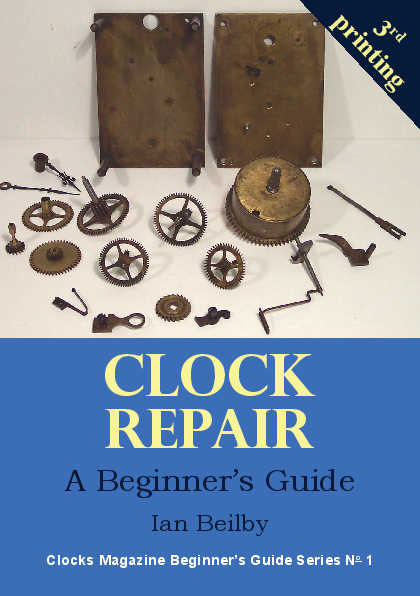
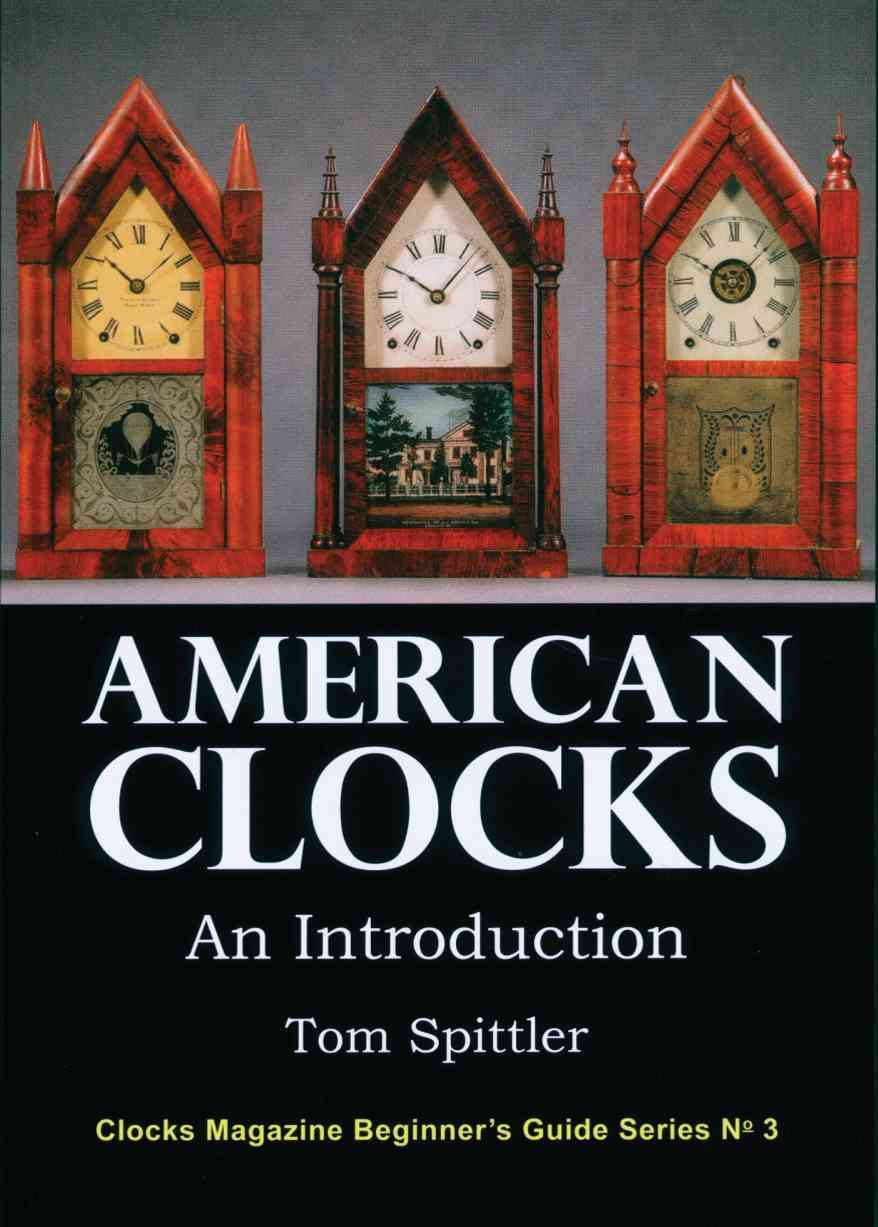
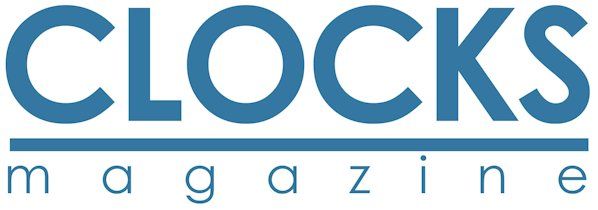
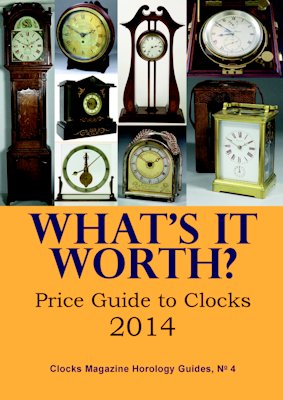
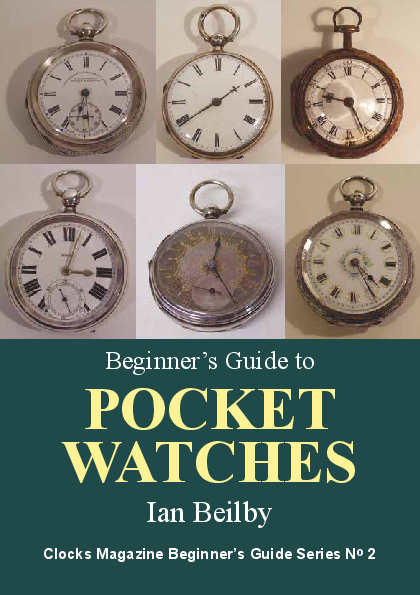
|
|
| from Clocks Magazine, Sepember 2004 | |
Dating a longcase clockby Dennis Radage, CanadaDownload a pdf of this article There are usually two key questions that always seem to be asked when presented with an antique clock. These are: 1. When was my clock made? 2. What is my clock worth? There’s actually a third question that is rarely asked, usually deliberately (or ignorantly) ignored, and a subject that the owner would often prefer not to investigate. This third question is: 3. Is my clock authentic and original in all respects? This is an important question, and one that the owner does not seem to understand, nor its relevance to the first two questions. The easy answers to these questions, and the ones that are far too frequently employed, are to simply jot down the name of the maker, usually engraved on the dial or chapter ring, then to look in any one of the many books of makers. The maker will likely be listed with a working date and possibly other useful information. The worth (or value) will of course be concluded by looking at the best clocks available in a respectable dealer’s showroom. These questions apparently can be answered quickly for some, thus leaving the owner with a date range and usually an over-inflated price. In terms of originality however, the astute specialist would quickly question a marquetry, walnut and ebony cased clock with a painted dial. Originality is critically important, both in confirming the age and in determining the real value of the clock. The lack of originality may not be quite as radical as the example just mentioned, but there are many altered clocks, marriages, fakes and ones with subtle changes that can fool the unsuspecting. This article does not delve into the issue of value, since this can be very complex, and is dependent on the intended use of the appraisal, be it for insurance purposes, liquidation, probate or for one of several other reasons. Each intended use will generate a quite different value for the same clock at the same point in time. As we will see, in properly dating a clock, authenticity or originality is often resolved in the process. The principles to be used here apply to most English clocks, and some American ones as well, but the focus of this article will be based on just one interesting example. It is extremely important to remember that there are always exceptions to every rule, and unfortunately, there are lots of exceptions. Each clockmaker was an individual; he may have followed general styles and tastes, but he invariably also exploited some of his own talents, individualism and preferences. I believe most of us know that clocks did evolve through distinct periods, styles, wood types, dial shapes, sizes and types, and of course through the introduction of specialisation, mass production and ‘factory’ produced clocks. We can also be reasonably confident that the clockmaker and cabinetmaker, who made the case, were not the same. These were likely different tradesmen, right from the earliest times. Only the clockmaker signed the clock, and usually, just on the dial. Most makers tended to follow the style of the day. But, from about 1700, they increasingly ordered at least some of their parts, whether it be hands, spandrels, gut line etc, from a parts supplier. By 1850, most clocks were assembled from bought-in parts, including complete bought-in movements which were available even in the late 18th century. The clock that I will use to explain the process is a mahogany cased (veneered), brass dial, musical longcase clock. It has a 12in dial and the clock stands 256cm or 101in high (that’s 8ft 5in), and the name on the dial is George Prior, London, figure 1. Most serious horological books will suggest that the name on the dial should be the last place to start dating a clock. There are lots of forgeries on the market, many with names added later. We also need to consider that names had errors: clockmakers often couldn’t spell; similarly, engravers couldn’t spell either, or made errors in engraving. The use of certain letters and characters also evolved as did the spelling of names and places. During the 17th century right through to the early 19th century many makers ‘Latinised’ their names. ‘John’ may thus be engraved as ‘Johannes’ and ‘London’ as ‘Londinii’ etc. ‘John’ might also be abbreviated to just ‘Jno’ and to complicate matters, ‘J’ and ‘I’ were often interchangeable, so ‘Jno’ might be engraved as ‘Ino’, also meaning ‘John’. There are many such examples, like ‘W’ often being engraved to look like an ‘N’, or even a ‘U’. So ‘Nencastle’ should be read as ‘Newcastle’ and ‘Lauson’ as ‘Lawson’, but not to be confused with ‘Lanson’. Several specialists suggest that there was no such thing as a fixed spelling. So identifying a clock just from its name can be difficult and needs careful study. What is very disturbing is that many, if not most, longcase clocks found today are marriages, or otherwise substantially modified. These clocks demand considerably less value than a clock where all of the parts started out life together, as just one original clock. When buying therefore, it is best to approach a reputable dealer, or to learn the identification process yourself. So where should we start? A suitable methodical process is to examine and date the case, the dial and the movement details, all separately. First we must identify the type and style of all of the components. We must judge whether they are contemporary, whether they belong together, and whether they likely started life together as one clock. If all of the feasible date ranges for all of the components overlap, there is a good probability that you have an authentic clock, not a marriage. Such a clock could be quite valuable. The date of a specific clock would usually be within the overlapping period, but generally toward the most modern or latest dating component or style, figure 2. We must consider that the maker may have carried over older designs, parts or styles, or was just using up old stock. Since George Prior is such a well-known and respected maker, I will cheat a little: George Prior is recorded as a London maker, well known and distinguished, a supplier to the home, English market, and to the Turkish market. His clocks and watches are sought after and are held in high regard in many collections. Prior was born in 1747 and died in 1820 (according to Baillie). He worked from 31 Prescot St, Goodmans Fields, London, between 1765 and 1788; Lombard St, to 1810 and George Yard, to 1812. Ord-Hume in his book Musical Clocks, suggests that ‘Prior was a maker of repute and one of the most respected clockmakers of his age, specially for sales to the Turkish market and for producing good musical clocks. He appears to have purchased at least some of his movements from Thwaits & Reed, a parts and movement supplier’. So, with that little bit of knowledge, let’s apply the component analysis process to this clock and see what we find. We can quickly determine the following. The case is mahogany. Mahogany was used increasingly from about 1740, and on the majority of clocks after about 1760. The dial is brass and arched. Brass dials pre-dated longcase clocks, being used for lantern and table clocks of much earlier times. We do know that brass dials all but ceased in Victorian times, being replaced by painted dials in the late 18th century and beyond. Arch dials began about 1715 and continued as the preferred style through to current times. 
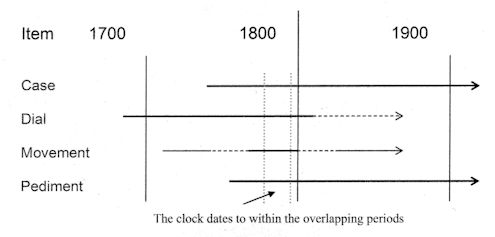
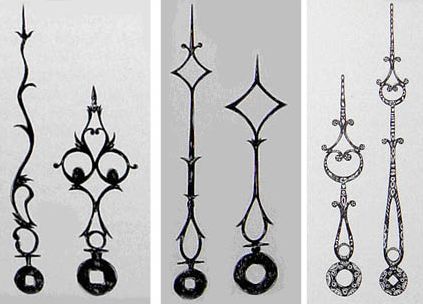
The hands are non-matching steel. Matching hands started about the same time as the painted dial, in the early 1770s. They were initially steel but migrated to brass, particularly for painted dials, by c1800. Before 1770, hands were non-matching and made of blued steel, figure 3. The weights are brass cased and lead filled. Early weights were lead, better quality clocks had brass-cased weights after about 1670, but diminishing over the next 100 years in favour of the cheaper cast-iron weights. Brass covered weights regained popularity in the late Victorian time to the present day. The movement is a heavy, good quality brass plated musical movement. These movements were popular from about 1770 to about 1800, then again in the late Victorian period. Prior is recorded as often buying his movements. This movement is unmarked but follows the lines of the last quarter of the 18th century. If we look at the wheels and arbors, we can see that the collets are extended and squared and the arbors have parallel sides, both consistent with a clock of the last quarter of the 18th century or later, figure 4. The plate pillars are of fairly standard form, except that they are tapered, suggesting a late 18th century design, figure 5, pillar 3. For a more detailed analyses of component designs and dates, refer for example to Brian Loomes’ book, Grandfather Clocks and their Cases (see Bibliography). The clock case has a carved swan-neck pediment. Swan necks increased in popularity from the mid 18th century to the present time. London swan-neck cases are known, but they are very rare. Most London clocks of the time have arched or pagoda tops, figure 6. Swan necks are predominantly a provincial feature, although it is possible, but unlikely, that London makers custom made features such as the swan-neck pediment for a provincial customer. 
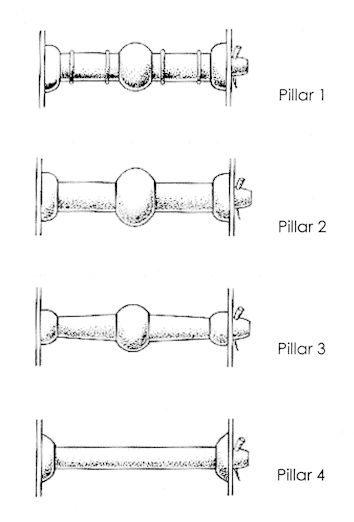
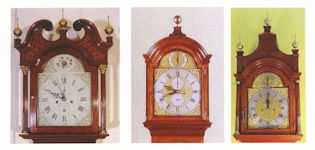
The case is highly decorative with blind frets to the hood, trunk and canted corners to the trunk and base. We have fluted columns and carved rosettes to the swan neck. This case is typical of the late 18th century. We know that London clocks tend to be plainer than provincial ones. This well-made case is of good quality and seems to be of the Lancashire style. So far, everything tends to fall in line for a clock of the last quarter of the18th century, which also concurs with Prior’s working period, figure 7. So far so good. However, we do have a possible discrepancy. Prior was a London maker and the case suggests a Lancashire style. We need to look in more detail. The chapter ring is an applied, silvered brass ring, normal for this type of clock, but the features are of an earlier period. This chapter ring has half-hour markers; these had all but disappeared by 1780, and usually before 1760. It also has an inner quarters circle, a style of the one-handed clock that was carried over to early two-handed clocks for the benefit of those who could not yet read minutes. This was phased out by about 1740. The chapter ring also has half-quarter markers, these were very unusual after first quarter 18th century, figure 8. The dial plate has wheatear engraving all around the outer edges, figure 9, a feature of the better clocks, but again phased out by first quarter of the 18th century. The dial plate is solid, so it is likely a London dial. Provincial dial plates often have cartwheel type cut-outs behind the chapter ring to save brass. The spandrels are of the female head type which were used between 1715 and 1745, figure 10. The arch has dolphin spandrels. These latest features now suggest that the dial was not made for this clock, and is probably 70 to 80 years older than the movement and case. 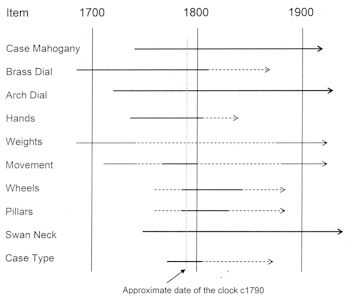
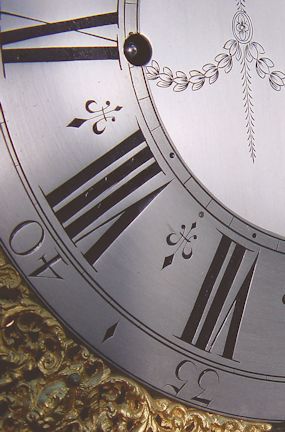

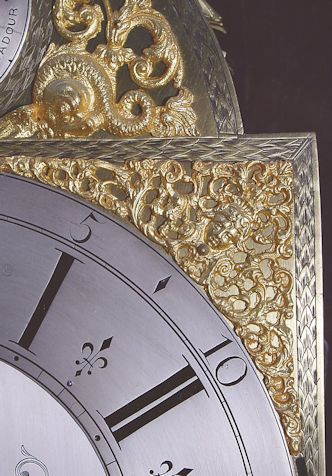
If we examine the back of the dial we will find several sets of holes, figure 11. Not only was this dial re-drilled to fit this movement, but the chapter ring could also be foreign to the dial. There are two sets of chapter ring mounting holes. Being observant, we will also see that the striking and chiming winding arbors pierce the chapter ring through its inner edge and into the quarters circle, figure 12. Prior would likely not have done that! All three winding arbors would have been in the centre section of the dial plate. Examination of the centre section of the dial, which would normally be matted brass on London clocks of the time, shows that this has been cut out and replaced, figure 13. Although carefully done, it was obviously replaced to remove inappropriately positioned winding holes and possibly a name. This new centre section has been screwed to the chapter ring—a method that wouldn’t have been used by the original clockmaker. The engraving in this new centre section does not match the rest of the dial, figure 14. We can see that the dial fits very well into the case and hood. We would expect the movement to fit the dial well because the mounting holes were drilled to make it fit well. So if we have a foreign dial, and no packing or adjustments to the seatboard, why does it fit so well? Careful scrutiny of the case shows that new cheeks have been glued into the case to achieve a near perfect fit, figure 15. This would fool most casual observers. The change seems to have been made some time ago! 
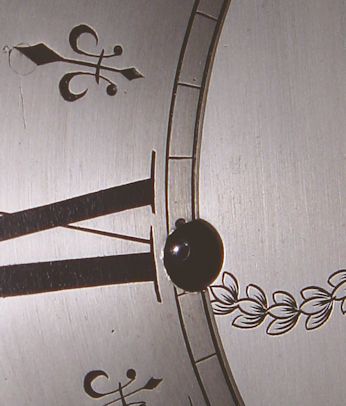
Now for the obvious; amongst the tunes on the tune selector we can find ‘Westminster Chimes’, figure 16. Westminster Chimes, formally known as the Cambridge Chimes, was written for St Mary’s Church, Cambridge in c1790. However, the name didn’t become Westminster Chimes until after 1859 when the Westminster clock was commissioned. After about 1870, the tune became very popular on many quarter chiming clocks. This clock chimes the quarters on eight bells, but strikes the hours on a gong attached to the backboard, figure 17. Gongs however, were not used in 1790 and were generally not in use until much later in the 19th century, a late Victorian preference. 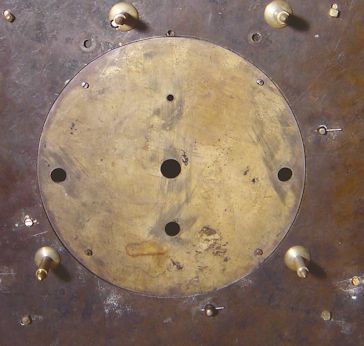
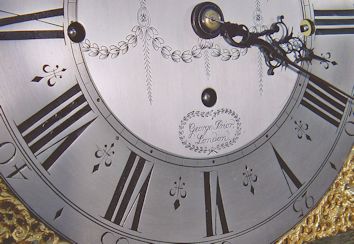
As figure 18 shows, we have: 1. A late 18th century case, c1790 2. An early 18th century dial, c1720 3. An equally early 18th century chapter ring, c1720/30 4. A late 18th century movement, c1790/00 5. A late 19th century musical drum, c1880/90 6. A late 19th century gong, c1880/90 7. Hands of last quarter of the 18th century, c1780/90 8. A mix of weights, probably, c1780-c1890 Given this information therefore, it is highly probable that this clock was modified and made up in the last quarter of the 19th century, obviously from old and new (to the time) parts. The movement probably was originally made to fit a 13in or 14in dial plate. The average age however, is still well over 100 years old, so at least we do have a genuine antique! 
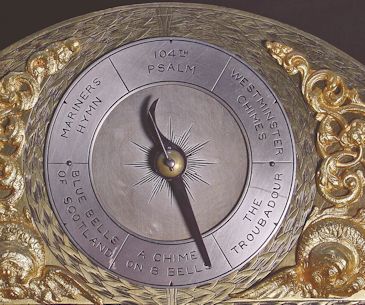

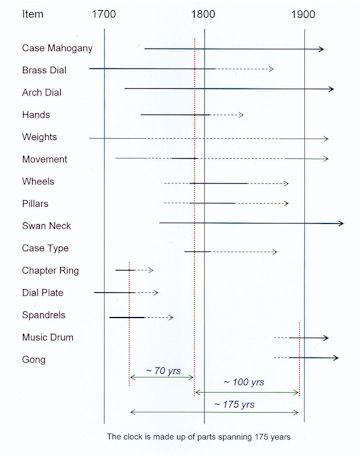
This clock is an obvious marriage. We don’t know the reason, whether it was custom-built for a client, assembled by a clockmaker out of spare parts, or whether it was a deliberate forgery to fool the unsuspecting clock lover. The name George Prior was almost certainly added 100 years after he was an active maker. Did George Prior ever see any part of this clock? Maybe, but we will probably never know. His name could have been the one that was cut from the original dial. This process has thus taught us that: 1. We cannot date this clock from the name on the dial, 2. We can’t date it from the case, 3. We can’t even date it from the dial or the movement. Unfortunately today, many clocks are in a similar condition, give or take a few alternative changes. What we do know about this clock is that the parts individually are of good design and of high quality, and likely from reputable makers. We also have a stately looking longcase clock that will likely give another 200 years of enjoyment. Given the pleasing lines and the quality of the components, it is easy to imagine its attraction to antique clock lovers. I do hope that this process has taught readers some of the basic principles to be used when buying an antique clock. It is really important that you conduct a full analysis of any piece that you are contemplating buying; after all, in addition to acquiring a clock that is appealing to you, value is always an important consideration. Value definitely does depend upon age, maker, originality and of course condition, amongst others. Bibliography Grandfather Clocks and Their Cases, 1992, by Brian Loomes, published by David & Charles. The Longcase Clock, 1979, by Eric Bruton, published by Granada. English Country Grandfather Clocks, 1983, by Richard Barder, published by Bracken Books. The Musical Clock, 1995, by Arthur Ord-Hume, published by Mayfield Books. The Concise Guide to British Clocks, 1992, by Brian Loomes, published by Barrie Jenkins. Brittens Old Clocks & Watches and Their Makers 9th Edition, 1989, by F J Britten, published by Bloomsbury. Watchmakers and Clockmakers of the World, Volumes 1 and 2, by G H Baillie and Brian Loomes, published by nag Press. The Longcase Clock Reference Book, 2001, by John Robey, published by Mayfield Books. Download a pdf of this article © 1977 to 2015 Clocks Magazine & Splat Publishing Ltd | |